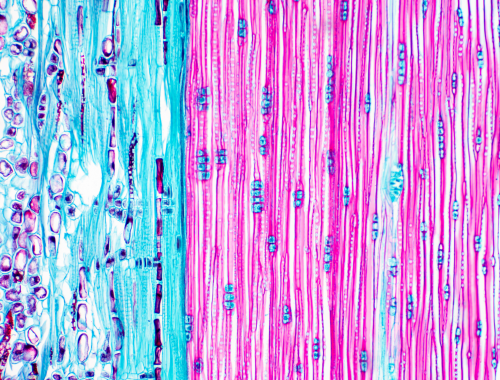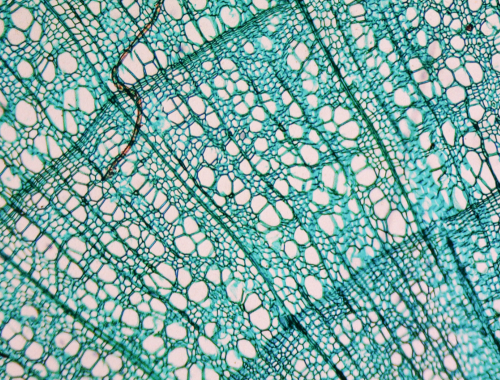Difference Between Vascular Cambium and Cork Cambium
The vascular cambium is the outside cylindrical secondary meristem layer, which later forms the secondary xylem and secondary phloem.
Cork cambium is the layer of parenchyma and collenchyma cells that are derived from the secondary lateral meristem.

What is Vascular cambium?
Definition:
The vascular cambium is the outside cylindrical secondary meristem layer, which later forms the secondary xylem and secondary phloem.
Location:
Vascular cambium is found between the primary xylem and primary phloem.
Development:
The vascular cambium originates from the apical meristem.
Function:
Vascular cambium is the vascular conduit inside the plant and it also provides stiffness and structural support to the plant.
Structures produced:
The vascular cambium gives rise to the medullary rays, secondary xylem, and secondary phloem.

What is Cork cambium?
Definition:
Cork cambium is the layer of parenchyma and collenchyma cells that are derived from the secondary lateral meristem.
Location:
Cork cambium is found outside the vascular structures of a plant.
Development:
Cork cambium is derived from the secondary lateral meristem.
Function:
Cork cambium helps to retain water and moisture in a plant and gives protection from environmental stresses.
Structures produced:
Cork cambium forms the bark and secondary cortex.
Difference between Vascular cambium and Cork cambium
Definition:
The vascular cambium is the outside cylindrical secondary meristem layer, which later forms the secondary xylem and secondary phloem. Cork cambium is the layer of parenchyma and collenchyma cells that are derived from the secondary lateral meristem.
Location:
Vascular cambium is found between the primary xylem and primary phloem. Cork cambium is found outside the vascular structures of a plant.
Development:
The vascular cambium originates from the apical meristem. Cork cambium is derived from the secondary lateral meristem.
Function:
Vascular cambium is the vascular conduit inside the plant and it also provides stiffness and structural support to the plant. Cork cambium helps to retain water and moisture in a plant and gives protection from environmental stresses.
Structures produced:
The vascular cambium gives rise to the medullary rays, secondary xylem, and secondary phloem. Cork cambium forms the bark and secondary cortex.
Table of difference between Vascular cambium and Cork cambium

FAQs
What is the difference between vascular cambium and vascular tissue?
Vascular tissue consists of vascular bundles whereas vascular cambium is one part of the vascular tissue.
What is the difference between cork and cork cambium?
Cork is the outermost layer of a plant. The Cork cambium is the layer of parenchyma and collenchyma cells that are derived from the secondary lateral meristem and beneath the cork.
What role do the vascular cambium and cork cambium play in secondary growth?
The vascular cambium gives rise to the medullary rays, secondary xylem, and secondary phloem. Cork cambium forms the bark and secondary cortex.
What is the function of the cork cambium?
Cork cambium helps to retain water and moisture in a plant and gives protection from environmental stresses.
What does the cork cambium include?
Cork cambium is the layer of parenchyma and collenchyma cells.
- Differences Between Reptiles and Amphibians - May 17, 2024
- Difference Between Ophthalmology and Optometry - May 15, 2024
- Difference Between Fear and Anxiety - April 2, 2024
Search DifferenceBetween.net :
Leave a Response
References :
[0]Vulavala, Vijaya KR, et al. "The transcriptome of potato tuber phellogen reveals cellular functions of cork cambium and genes involved in periderm formation and maturation." Scientific reports 9.1 (2019): 10216.
[1]Lier, Frank G. "The origin and development of cork cambium cells in the stem of Pelargonium hortorum." American Journal of Botany (1955): 929-936.
[2]Larson, Philip R. The vascular cambium: development and structure. Springer Science & Business Media, 2012.
[3]Image credit: https://www.canva.com/photos/MAD2CKi9Il8-histological-structure-of-pine-stem-vascular-bundle-under-the-microscope-/
[4]Image credit: https://www.canva.com/photos/MABHHR6RkfY-tilia-stem-micrograph/
